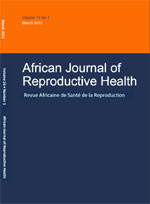
|
African Journal of Reproductive Health
Women's Health and Action Research Centre
ISSN: 1118-4841
Vol. 16, No. 3, 2012, pp. 93-100
|
 Bioline Code: rh12046
Bioline Code: rh12046
Full paper language: English
Document type: Research Article
Document available free of charge
|
|
|
African Journal of Reproductive Health, Vol. 16, No. 3, 2012, pp. 93-100
| fr |
Monjok, Emmanuel; Okokon, Ita B.; Opiah, Margaret M.; Ingwu, Justin A.; Ekabua, John E. & Essien, Ekere J.
Résumé
Symphysiotomie est une opération dans laquelle les fibres de la symphyse pubienne sont partiellement divisées pour permettre la séparation de l'articulation et permet en conséquence l'élargissement commune et des dimensions du bassin, facilitant ainsi l'accouchement vaginal des fœtus en présence d'une disproportion céphalo-pelvienne d'intensité légère à modéré. Elle est réalisée sous l'anesthésie locale, et n'exige pas une salle d'opération ou des compétences chirurgicales avancées en chirurgie. Elle peut être une procédure de sauvetage pour la mère et le bébé dans les dystocies, surtout dans les zones rurales dont les ressources sont limitées des pays en développement, où une opération césarienne ne peut être assurée pour 24 heures par jour. C'est est une technologie simple qui est sous-utilisés et qui peuvent être pratiquée par un médecin qualifié ou une sage- femme dans les établissements de santé ruraux et les hôpitaux où la plupart du temps, au Nigeria, il n'y a pas d'obstétriciens spécialisés exerçant. Dans les hôpitaux ruraux et dans les communautés où la sympysiotomie est toujours pratiquée, il est évident qu'il est préférable à l'opération césarienne en raison de la volonté socioculturelle pour parvenir à un accouchement vaginal. Cet article met en lumière nos expériences avec la symphysiotomie dans un hôpital rural catholique romain et fournit des preuves sur la sécurité de la symphysiotomie et la nécessité de sa renaissance et de sa réintégration dans l'arsenal obstétrique au Nigeria et les pays similaires en Afrique sub-saharienne où la mortalité maternelle se produire toujours à cause de la dystocie prolongée et négligée (Afr J Reprod Health 2012; 16[3]: 93-100).
|
| |
| en |
Obstructed Labour in Resource-poor Settings: The Need for Revival of Symphysiotomy in Nigeria
Monjok, Emmanuel; Okokon, Ita B.; Opiah, Margaret M.; Ingwu, Justin A.; Ekabua, John E. & Essien, Ekere J.
Abstract
Symphysiotomy is an operation in which the fibres of the pubic symphysis are partially divided to allow separation of the joint and thus enlargement of the pelvic dimensions thereby facilitating vaginal delivery of the foetus in the presence of mild to moderate cephalopelvic disproportion. It is performed with local anaesthesia, does not require an operating theatre or advanced surgical skills. It can be a lifesaving procedure for both mother and baby in obstructed labour, especially in rural areas and resource-poor settings of developing countries, where a 24 hours availability of a caesarean section cannot be guaranteed. It is a simple underused technology that can be performed by a graduate doctor or midwife in rural health facilities and hospitals where most of the times, in Nigeria, there are no practicing specialist obstetricians. In rural hospital and in communities where sympysiotomy is still being performed, it is evident that it is preferred to caesarean section because of the socio-cultural desire to achieve a vaginal delivery. This paper highlights our experiences with symphysiotomy in a rural Roman Catholic hospital providing evidence on the safety of symphysiotomy and the need for its revival and reinstatement in the obstetric arsenal in Nigeria and similar countries in sub-Saharan Africa where maternal mortality as a result of prolonged and neglected obstructed labour still occur (Afr J Reprod Health 2012; 16[3]: 93-100).
Keywords
Obstructed Labour, cephalo-pelvic disproportion, symphysiotomy, resource-poor communities, Nigeria
|
| |
© Copyright 2012 - Women's Health and Action Research Centre
Alternative site location: http://www.ajrh.info
|
|
